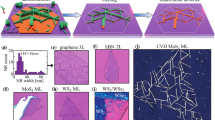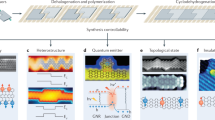Abstract
Graphene-based nanostructures exhibit electronic properties that are not present in extended graphene. For example, quantum confinement in carbon nanotubes and armchair graphene nanoribbons leads to the opening of substantial electronic bandgaps that are directly linked to their structural boundary conditions1,2. Nanostructures with zigzag edges are expected to host spin-polarized electronic edge states and can thus serve as key elements for graphene-based spintronics3. The edge states of zigzag graphene nanoribbons (ZGNRs) are predicted to couple ferromagnetically along the edge and antiferromagnetically between the edges4, but direct observation of spin-polarized edge states for zigzag edge topologies—including ZGNRs—has not yet been achieved owing to the limited precision of current top-down approaches5,6,7,8,9,10. Here we describe the bottom-up synthesis of ZGNRs through surface-assisted polymerization and cyclodehydrogenation of specifically designed precursor monomers to yield atomically precise zigzag edges. Using scanning tunnelling spectroscopy we show the existence of edge-localized states with large energy splittings. We expect that the availability of ZGNRs will enable the characterization of their predicted spin-related properties, such as spin confinement11 and filtering12,13, and will ultimately add the spin degree of freedom to graphene-based circuitry.
This is a preview of subscription content, access via your institution
Access options
Subscribe to this journal
Receive 51 print issues and online access
$199.00 per year
only $3.90 per issue
Buy this article
- Purchase on Springer Link
- Instant access to full article PDF
Prices may be subject to local taxes which are calculated during checkout




Similar content being viewed by others
References
Saito, R., Fujita, M., Dresselhaus, G. & Dresselhaus, M. S. Electronic structure of graphene tubules based on C60 . Phys. Rev. B 46, 1804–1811 (1992)
Wakabayashi, K., Fujita, M., Ajiki, H. & Sigrist, M. Electronic and magnetic properties of nanographite ribbons. Phys. Rev. B 59, 8271–8282 (1999)
Han, W., Kawakami, R. K., Gmitra, M. & Fabian, J. Graphene spintronics. Nature Nanotechnol. 9, 794–807 (2014)
Nakada, K., Fujita, M., Dresselhaus, G. & Dresselhaus, M. S. Edge state in graphene ribbons: nanometer size effect and edge shape dependence. Phys. Rev. B 54, 17954–17961 (1996)
Han, M. Y., Ozyilmaz, B., Zhang, Y. & Kim, P. Energy band-gap engineering of graphene nanoribbons. Phys. Rev. Lett. 98, 206805 (2007)
Kosynkin, D. V. et al. Longitudinal unzipping of carbon nanotubes to form graphene nanoribbons. Nature 458, 872–876 (2009)
Li, X., Wang, X., Zhang, L., Lee, S. & Dai, H. Chemically derived, ultrasmooth graphene nanoribbon semiconductors. Science 319, 1229–1232 (2008)
Wang, X. & Dai, H. Etching and narrowing of graphene from the edges. Nature Chem. 2, 661–665 (2010)
Magda, G. Z. et al. Room-temperature magnetic order on zigzag edges of narrow graphene nanoribbons. Nature 514, 608–611 (2014)
Ma, L., Wang, J. & Ding, F. Recent progress and challenges in graphene nanoribbon synthesis. ChemPhysChem 14, 47–54 (2013)
Topsakal, M., Sevinçli, H. & Ciraci, S. Spin confinement in the superlattices of graphene ribbons. Appl. Phys. Lett. 92, 173118 (2008)
Wimmer, M., Adagideli, İ., Berber, S., Tománek, D. & Richter, K. Spin currents in rough graphene nanoribbons: universal fluctuations and spin injection. Phys. Rev. Lett. 100, 177207 (2008)
Son, Y.-W., Cohen, M. L. & Louie, S. G. Half-metallic graphene nanoribbons. Nature 444, 347–349 (2006)
Cai, J. et al. Atomically precise bottom-up fabrication of graphene nanoribbons. Nature 466, 470–473 (2010)
Chen, Y.-C. et al. Tuning the band gap of graphene nanoribbons synthesized from molecular precursors. ACS Nano 7, 6123–6128 (2013)
Zhang, H. et al. On-surface synthesis of rylene-type graphene nanoribbons. J. Am. Chem. Soc. 137, 4022–4025 (2015)
Bronner, C. et al. Aligning the band gap of graphene nanoribbons by monomer doping. Angew. Chem. Int. Ed. 52, 4422–4425 (2013)
Cai, J. et al. Graphene nanoribbon heterojunctions. Nature Nanotechnol. 9, 896–900 (2014)
Chen, Y.-C. et al. Molecular bandgap engineering of bottom-up synthesized graphene nanoribbon heterojunctions. Nature Nanotechnol. 10, 156–160 (2015)
Gross, L., Mohn, F., Moll, N., Liljeroth, P. & Meyer, G. The chemical structure of a molecule resolved by atomic force microscopy. Science 325, 1110–1114 (2009)
Li, Y., Zhang, W., Morgenstern, M. & Mazzarello, R. Electronic and magnetic properties of zigzag graphene nanoribbons on the (111) surface of Cu, Ag, and Au. Phys. Rev. Lett. 110, 216804 (2013)
Repp, J., Meyer, G., Stojković, S. M., Gourdon, A. & Joachim, C. Molecules on insulating films: scanning-tunneling microscopy imaging of individual molecular orbitals. Phys. Rev. Lett. 94, 026803 (2005)
Yang, L., Park, C.-H., Son, Y.-W., Cohen, M. L. & Louie, S. G. Quasiparticle energies and band gaps in graphene nanoribbons. Phys. Rev. Lett. 99, 186801 (2007)
Ritter, K. A. & Lyding, J. W. The influence of edge structure on the electronic properties of graphene quantum dots and nanoribbons. Nature Mater. 8, 235–242 (2009)
Tao, C. et al. Spatially resolving edge states of chiral graphene nanoribbons. Nature Phys. 7, 616–620 (2011)
van der Lit, J. et al. Suppression of electron–vibron coupling in graphene nanoribbons contacted via a single atom. Nature Commun. 4, 2023 (2013)
Li, Y. Y., Chen, M. X., Weinert, M. & Li, L. Direct experimental determination of onset of electron–electron interactions in gap opening of zigzag graphene nanoribbons. Nature Commun. 5, 4311 (2014)
Dutta, S. & Wakabayashi, K. Tuning charge and spin excitations in zigzag edge nanographene ribbons. Sci. Rep. 2, 519 (2012)
Yang, L., Cohen, M. L. & Louie, S. G. Magnetic edge-state excitons in zigzag graphene nanoribbons. Phys. Rev. Lett. 101, 186401 (2008)
Yazyev, O. V. A guide to the design of electronic properties of graphene nanoribbons. Acc. Chem. Res. 46, 2319–2328 (2013)
Li, Y., Zhou, Z., Cabrera, C. R. & Chen, Z. Preserving the edge magnetism of zigzag graphene nanoribbons by ethylene termination: insight by Clar’s rule. Sci. Rep. 3, 2030 (2013)
Giessibl, F. J. Atomic resolution on Si(111)-(7 × 7) by noncontact atomic force microscopy with a force sensor based on a quartz tuning fork. Appl. Phys. Lett. 76, 1470–1472 (2000)
Bartels, L. et al. Dynamics of electron-induced manipulation of individual co molecules on Cu(111). Phys. Rev. Lett. 80, 2004–2007 (1998)
Giannozzi, P. et al. QUANTUM ESPRESSO: a modular and open-source software project for quantum simulations of materials. J. Phys. Condens. Matter 21, 395502 (2009)
Goedecker, S., Teter, M. & Hutter, J. Separable dual-space Gaussian pseudopotentials. Phys. Rev. B 54, 1703–1710 (1996)
VandeVondele, J. & Hutter, J. Gaussian basis sets for accurate calculations on molecular systems in gas and condensed phases. J. Chem. Phys. 127, 114105 (2007)
Perdew, J. P., Burke, K. & Ernzerhof, M. Generalized gradient approximation made simple. Phys. Rev. Lett. 77, 3865 (1996)
Marini, A., Hogan, C., Grüning, M. & Varsano, D. yambo: an ab initio tool for excited state calculations. Comput. Phys. Commun. 180, 1392–1403 (2009)
Godby, R. W. & Needs, R. J. Metal-insulator transition in Kohn-Sham theory and quasiparticle theory. Phys. Rev. Lett. 62, 1169–1172 (1989)
Rozzi, C. A., Varsano, D., Marini, A., Gross, E. K. U. & Rubio, A. Exact Coulomb cutoff technique for supercell calculations. Phys. Rev. B 73, 205119 (2006)
Acknowledgements
This work was supported by the Swiss National Science Foundation, the Office of Naval Research BRC Program, the European Research Council (grant NANOGRAPH), the DFG Priority Program SPP 1459, the Graphene Flagship (No. CNECT-ICT-604391), and the European Union Projects UPGRADE, GENIUS and MoQuaS. We acknowledge the Swiss Supercomputing Center (CSCS) for computational resources (project s507). We thank A. Ferretti for his contribution to this project and O. Gröning for discussions.
Author information
Authors and Affiliations
Contributions
P.R., R.F., X.F. and K.M. conceived and supervised the experiments. B.Y. and T.Du. synthesized the precursor monomers. J.L. and C.S. developed the on-surface synthesis protocols and did the STM analysis. T.Di., J.L. and S.W. performed the AFM imaging; S.W. and J.L. did the spectroscopic analysis. P.S., L.T., C.A.P. and D.P. performed the simulations. C.S., S.W. and P.R. made the figures. P.R., K.M. and R.F. wrote the paper. All authors discussed the results and implications and commented on the manuscript at all stages.
Corresponding authors
Ethics declarations
Competing interests
The authors declare no competing financial interests.
Supplementary information
Supplementary Information
This file contains Supplementary Methods (syntheses of monomers), Supplementary Figures 1-11 and additional references. (PDF 5251 kb)
Supplementary Data
This file contains Crystal Structure Data 1a (single crystal of BrBD-Umbrella). (CIF 21 kb)
Rights and permissions
About this article
Cite this article
Ruffieux, P., Wang, S., Yang, B. et al. On-surface synthesis of graphene nanoribbons with zigzag edge topology. Nature 531, 489–492 (2016). https://doi.org/10.1038/nature17151
Received:
Accepted:
Published:
Issue Date:
DOI: https://doi.org/10.1038/nature17151
This article is cited by
-
Stepwise on-surface synthesis of nitrogen-doped porous carbon nanoribbons
Communications Chemistry (2024)
-
Precise determination of molecular adsorption geometries by room temperature non-contact atomic force microscopy
Communications Chemistry (2024)
-
Prediction of highly stable 2D carbon allotropes based on azulenoid kekulene
Nature Communications (2024)
-
Tailoring graphene for electronics beyond silicon
Nature (2024)
-
Surface-confined alternating copolymerization with molecular precision by stoichiometric control
Nature Communications (2024)
Comments
By submitting a comment you agree to abide by our Terms and Community Guidelines. If you find something abusive or that does not comply with our terms or guidelines please flag it as inappropriate.



